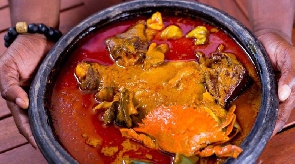Opinions of Friday, 21 October 2022
Columnist: Nana Yaw Asafo-Adjei
Culture & lifestyle
The path to a man's heart, it is said, is through the stomach. But is it only to a man's? No, it is a universal experience. I used to roll my eyes, however much I could, amused at the Ghanaian women when they began their usual "It is not the same". They would bring excess luggage on international flights if they had to, and brave customs officials in lands unknown with all things Ghanaian. We ask - "How did you manage to get - all - this through customs?" To which one gets, "I know how to wrap it well", etc. Actually, we kick up a fuss, when we see the volume of food items increasing by the hour at home, before departure for any flight. Worse is when you have to carry what is deemed a 'small' load on top of your light travel. "What am I going to say if some small customs officer over there pulls such and such out, and asks ... and in my suit? But all is forgotten when all that is set right there in front of us at the dinner table. I would tell my American friends, whether they care to know or not, that Ghanaian cuisine is to die for. And, would go on to be specific, giving a rendering of what I find troubling in my new home country. The best deep-dish pizzas I have ever had were in Ghana. Yes, Ghana of all places. They awakened the senses. Chinese fried rice, crispy spring rolls with a crunch - not with that solitary shrimp, East/Southern African samoosas - with translucent delicate pastry folding its rich, moist filling smelling of curry, green bell pepper, and other spices; fries with that earthy, not-MacDonalds flavor, and such. Those are but a few of my pet peeve foods. In fact, to tell you the truth, one is tempted to hurl some of those tasteless and dry comparable dishes across the room dining out here. But of course, proper food etiquette prevents us. Offer up a Ghanaian restaurant as a place to go eat as a suggestion, and you would have the outwardly sophisticated American look questionably at you as if to say what could possibly be there to eat. Not all, but one still does get that why-on-earth reaction every now and then. Other times, I get that generic excuse of the foreign cuisine in each country catering to the local palate; one cannot, therefore, expect all to be the same. To which I counter that cooking from the South in the US is as original as clam chowder is to New England, so we cannot compromise on the quality of any other dish elsewhere in the world. I am also asked how could any dish be possibly better than in the land from which it originates. They just cannot convince me that bland rice is authentically Chinese. It has got to be better than that. But enough of the digression here. If by now you have not noticed, I do enjoy my food. If it's no good, it's not worth my time, vexation, money, or eating it. Home-cooked meals are a sure way to almost guarantee that what you are about to have is just what it is supposed to be. However, that home-cooked food could very well belong in some fancy restaurant the world over. One would have that about 80% of the time, and the rest, with meals from around the world - Chinese, Japanese, Mexican, Mediterranean, french, and what have you. I so much seek that authenticity in Ghanaian cuisine in my life I do my fresh produce shopping buying "organic" at high-end and/or Ghana/other 'ethnic' food stores. But how come a lot of this exorbitant produce, supposedly from elsewhere, still have no taste? It's no exaggeration to say they taste like water, or even worse. One cannot tell whether what one puts in the mouth is green bell pepper, tomato, or an orange, even with all the spices or additives. Groundnut paste generates little or no oil, no matter how long it sits on the hot plate. It has no flavor. Growing up from the age of 8, well before Operation Feed Yourself or those heady days of the early 80s with the spotlight & bottom-up policy on agriculture, and at most sundowns after school, we would be in the backyard garden, or tending to the 'flower pots' that doubled in time as a vegetable patch. It was all-hands-on-deck with the cassava, groundnuts, okra, etc. We were proud to have what we grew as part of a meal. Meal time was, and continues to be today, a family affair, or even communal. Some even, still do, eat from the same wide bowl, inching forward from the periphery and towards the center. The youngest sitting at the bowl is left with the last few morsels. Even for one's own individual meal, one starts from one spot closest to you on the periphery, working one's way towards the center and beyond; in so doing, one could invite others to sit and eat, without making one's meal appear like leftovers. Sunday mornings after-church Omo-tuo; Abom with koobi, avocado pear, and soft-boiled egg eaten from blackened earthenware - ready at the break of dawn; kelewele with groundnuts by the smoking wick lamps in the vibrant nightlife; and, TZ with guinea fowl in the north fresh back from local subsistence farms as a young adult are a part of daily life in Ghana. We have something ... the richness of which is not just in the earth under our feet or out in the open seas, or only in the people or communities, but also in our foods. Jollof rice is gold and a drug. Yes, I'm addicted. Full disclosure: not all cooks are the same, and the jollof I cook is no match to that of Ghanaian women, no matter how much coaching. I have had the privilege of having frozen packaged foods to take along on my long trips. Sitting alone at my desk in my office one morning, and having brought out my serving of jollof, it hit me coming to that sudden realization that the rice was all gone. Up on my feet that very instant, if I had superman powers to find myself at the door thousands of miles away to replenish my supply I would have done just that. The flavorful, sweet-and-savory stews with fragrant aromas; the Ga kenkey and red-black, smoky, spicy mild-hot shitor or the freshly ground red cayenne pepper, tomato, and onions; fufu and different soups; the waakye with spaghetti-like talia, gari and a good helping of vegetables; the garden egg stew with ampesi; and, the wide variety of fresh or processed seafood/goat/cow meats finding their way into all these dishes are just a handful of examples deserving of mention. I have often heard some visiting say Ghana does not have any desserts or appetizers. I would add to that snacks, which one can see is blatantly false if one paid enough attention to what is sold by street vendors hawking their goods in vehicular traffic, or anywhere else. That's almost the same as that observation by some that there are hardly any recreational or amusement parks in Ghana or Accra; forget that we have always had the neighborhood hangouts - outside the homes or in the streets - or play in the nearby fields. Other than the western-influenced pastries, ice creams, chips, and cakes there is a long list of fruits, vegetables, and nuts - for example, roasted dry or fresh corn with roasted groundnuts or coconut (respectively), bofrot (buffloaf 'doughnuts', cassava balls kaaklo, plantain kaaklo, tatale and beans, aboodo, sugar cane, tiger nuts, all the varieties of kebab - - most of which are sold at car pull-ups or just down the street in the neighborhood. Ghanaians have, up to this point, largely succeeded in resisting the adulteration of their cuisine, with the massive imports not making any significant impact on the culture. Not surprising as many would mount that staunch defense of what they hold true and dear. But for just how long would that last? My last visit back home to Ghana, I was really puzzled as to what was happening to me. Of course, knowing what quality of food would be available to me, I had that all mapped out, well beforehand. I would wake up in the morning looking forward to the day, as maybe one would be on holiday/vacation, and not necessarily for business. Then, it is a "What are we having today?" or "What do you feel for today?". Then the recommendations start coming in; oh, I know of the best Hausa kooko-porridge and bean cake koose seller at the street corner. What I did not anticipate from all this was smiling from ear to ear while having my meals. At the end of each meal, my soul sighed. Is this what they mean by 'soul food' elsewhere? I have not smiled so much in my life as during those 2 weeks. Of course, there is also the continental breakfast, however far one wants to take that or fancies. Even those do not disappoint. Having said all that it is not everything I would eat. And that is just my personal predilection. There may be stuff that everyone raves about, but I am able to partake only so far. And that is fine. Presentation matters. The location one is offered or is buying, food from also matters. I also advocate for health-conscious cooking. Everything may not quite line up as far as the hygienic practices or the lack of them in varying degrees, but an acutely keen eye can help one zone in onto which street vendor or chop bar to patronize safely. It might take a minute to come round to all that spicy food, but once one is curious and open enough to sample, one will be hooked. Whilst we celebrate Ghanaian cuisine, let us remember there is famine elsewhere on the subcontinent. Like the ant that busily builds its food store for a rainy day, Ghanaians as individuals have not built their homes in their stomachs, and it is for our leaders to ensure there is food sufficiency and security to be able to feed its people and over.













